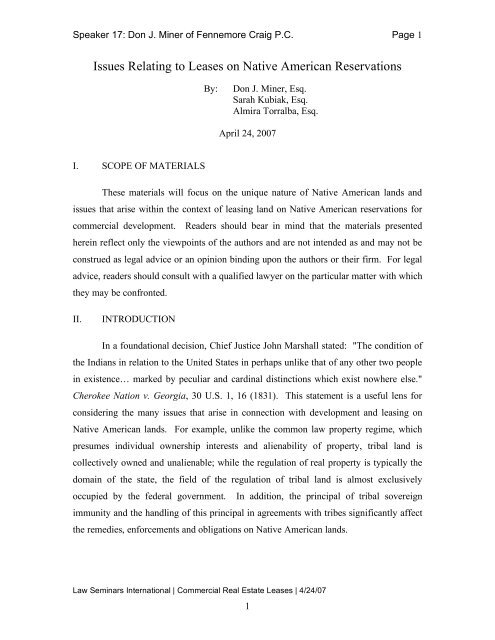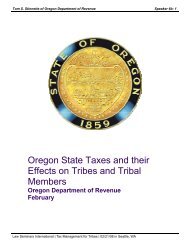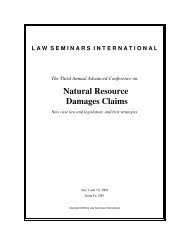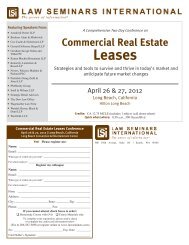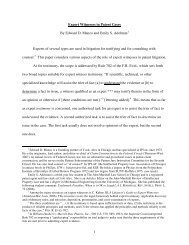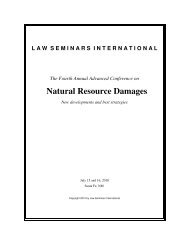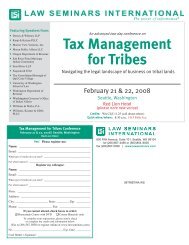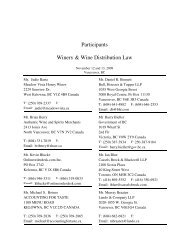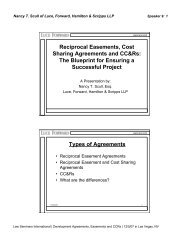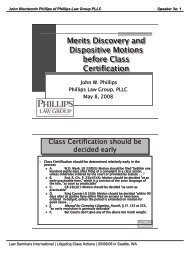Issues Relating to Leases on Native American Reservations
Issues Relating to Leases on Native American Reservations
Issues Relating to Leases on Native American Reservations
Create successful ePaper yourself
Turn your PDF publications into a flip-book with our unique Google optimized e-Paper software.
Speaker 17: D<strong>on</strong> J. Miner of Fennemore Craig P.C. Page 1<br />
<str<strong>on</strong>g>Issues</str<strong>on</strong>g> <str<strong>on</strong>g>Relating</str<strong>on</strong>g> <str<strong>on</strong>g>to</str<strong>on</strong>g> <str<strong>on</strong>g>Leases</str<strong>on</strong>g> <strong>on</strong> <strong>Native</strong> <strong>American</strong> Reservati<strong>on</strong>s<br />
By:<br />
D<strong>on</strong> J. Miner, Esq.<br />
Sarah Kubiak, Esq.<br />
Almira Torralba, Esq.<br />
April 24, 2007<br />
I. SCOPE OF MATERIALS<br />
These materials will focus <strong>on</strong> the unique nature of <strong>Native</strong> <strong>American</strong> lands and<br />
issues that arise within the c<strong>on</strong>text of leasing land <strong>on</strong> <strong>Native</strong> <strong>American</strong> reservati<strong>on</strong>s for<br />
commercial development. Readers should bear in mind that the materials presented<br />
herein reflect <strong>on</strong>ly the viewpoints of the authors and are not intended as and may not be<br />
c<strong>on</strong>strued as legal advice or an opini<strong>on</strong> binding up<strong>on</strong> the authors or their firm. For legal<br />
advice, readers should c<strong>on</strong>sult with a qualified lawyer <strong>on</strong> the particular matter with which<br />
they may be c<strong>on</strong>fr<strong>on</strong>ted.<br />
II.<br />
INTRODUCTION<br />
In a foundati<strong>on</strong>al decisi<strong>on</strong>, Chief Justice John Marshall stated: "The c<strong>on</strong>diti<strong>on</strong> of<br />
the Indians in relati<strong>on</strong> <str<strong>on</strong>g>to</str<strong>on</strong>g> the United States in perhaps unlike that of any other two people<br />
in existence… marked by peculiar and cardinal distincti<strong>on</strong>s which exist nowhere else."<br />
Cherokee Nati<strong>on</strong> v. Georgia, 30 U.S. 1, 16 (1831). This statement is a useful lens for<br />
c<strong>on</strong>sidering the many issues that arise in c<strong>on</strong>necti<strong>on</strong> with development and leasing <strong>on</strong><br />
<strong>Native</strong> <strong>American</strong> lands. For example, unlike the comm<strong>on</strong> law property regime, which<br />
presumes individual ownership interests and alienability of property, tribal land is<br />
collectively owned and unalienable; while the regulati<strong>on</strong> of real property is typically the<br />
domain of the state, the field of the regulati<strong>on</strong> of tribal land is almost exclusively<br />
occupied by the federal government. In additi<strong>on</strong>, the principal of tribal sovereign<br />
immunity and the handling of this principal in agreements with tribes significantly affect<br />
the remedies, enforcements and obligati<strong>on</strong>s <strong>on</strong> <strong>Native</strong> <strong>American</strong> lands.<br />
Law Seminars Internati<strong>on</strong>al | Commercial Real Estate <str<strong>on</strong>g>Leases</str<strong>on</strong>g> | 4/24/07<br />
1
Speaker 17: D<strong>on</strong> J. Miner of Fennemore Craig P.C. Page 2<br />
The following principles are central <str<strong>on</strong>g>to</str<strong>on</strong>g> all aspects of <strong>Native</strong> <strong>American</strong> law 1 :<br />
1. An Indian nati<strong>on</strong> possesses powers of a sovereign state and<br />
enjoys a government-<str<strong>on</strong>g>to</str<strong>on</strong>g>-government relati<strong>on</strong>ship with the United States.<br />
2. The federal government has broad authority <str<strong>on</strong>g>to</str<strong>on</strong>g> regulate Indian<br />
affairs, subject <str<strong>on</strong>g>to</str<strong>on</strong>g> c<strong>on</strong>stituti<strong>on</strong>al c<strong>on</strong>straints.<br />
3. State authority in Indian affairs is limited.<br />
4. <strong>Native</strong> <strong>American</strong> tribes c<strong>on</strong>stitute separate governmental<br />
authorities with regula<str<strong>on</strong>g>to</str<strong>on</strong>g>ry authority.<br />
III.<br />
SOURCES<br />
Researching a <strong>Native</strong> <strong>American</strong> law issue may require c<strong>on</strong>sulting a broad variety<br />
of sources including: the United States C<strong>on</strong>stituti<strong>on</strong>, principles of internati<strong>on</strong>al law,<br />
treaties with individual <strong>Native</strong> <strong>American</strong> tribes, federal statutes and regulati<strong>on</strong>s,<br />
executive orders, and judicial opini<strong>on</strong>s. It is important <str<strong>on</strong>g>to</str<strong>on</strong>g> keep in mind that each tribe has<br />
a unique relati<strong>on</strong>ship with the United States government. Laws that affect <strong>on</strong>e tribe may<br />
not necessarily affect all tribes. See, e.g., 25 U.S.C. § 416(a) ("Any c<strong>on</strong>tract, including a<br />
lease, affecting land within the Salt River Pima-Maricopa Indian Reservati<strong>on</strong> may<br />
c<strong>on</strong>tain a provisi<strong>on</strong> for the binding arbitrati<strong>on</strong> of disputes arising out of such c<strong>on</strong>tract.")<br />
Sources that pertain <str<strong>on</strong>g>to</str<strong>on</strong>g> leasing tribal property include the following:<br />
1. 25 U.S.C. § 415 et seq. (Indian L<strong>on</strong>g-Term Leasing Act)<br />
2. 25 CFR § 162 et seq. (Indians, <str<strong>on</strong>g>Leases</str<strong>on</strong>g> and Permits)<br />
3. Each tribe’s c<strong>on</strong>stituti<strong>on</strong>, codes and ordinances. Tribal codes and<br />
ordinances often functi<strong>on</strong> much like a municipality or a county.<br />
4. Case law of federal courts, especially the Supreme Court.<br />
1 The general principals outlined above are identified in COHEN'S HANDBOOK OF FEDERAL INDIAN<br />
LAW (2005), 1 - 3. Chapter 4 of COHEN'S ("Indian Tribal Governments") provides a detailed discussi<strong>on</strong><br />
of Indian tribal governments and their relati<strong>on</strong>ship <str<strong>on</strong>g>to</str<strong>on</strong>g> and interacti<strong>on</strong> with federal and state governments.<br />
Law Seminars Internati<strong>on</strong>al | Commercial Real Estate <str<strong>on</strong>g>Leases</str<strong>on</strong>g> | 4/24/07<br />
2
Speaker 17: D<strong>on</strong> J. Miner of Fennemore Craig P.C. Page 3<br />
IV.<br />
NATURE OF PROPERTY RIGHTS<br />
Tribal property is a form of ownership in comm<strong>on</strong> that is not analogous <str<strong>on</strong>g>to</str<strong>on</strong>g><br />
tenancy in comm<strong>on</strong> or other collective forms of ownership know <str<strong>on</strong>g>to</str<strong>on</strong>g> Anglo-<strong>American</strong><br />
private property law. COHEN'S, 966. An individual tribal owner has no alienable or<br />
inheritable interest in the communal holding. Id. Tribal property interests are held in<br />
comm<strong>on</strong> for the benefit of all living members of the tribe. Id.<br />
1. Tribal Trust Land: Tribal trust land is land held in trust by the<br />
federal government for the beneficial ownership of the tribe. 2 The land may be located<br />
within or outside the boundaries of the reservati<strong>on</strong>. The Bureau of Indian Affairs (BIA)<br />
has been delegated the resp<strong>on</strong>sibility for the administrati<strong>on</strong> and management of 55.7<br />
milli<strong>on</strong> acres of land held in trust by the United States for <strong>Native</strong> <strong>American</strong>s, Indian<br />
tribes, and Alaska <strong>Native</strong>s. 3<br />
2. Allotments: Allotments c<strong>on</strong>sist of parcels of land that either the<br />
federal government holds in trust for individual tribal members ("trust" allotments) or<br />
tribal members hold in fee subject <str<strong>on</strong>g>to</str<strong>on</strong>g> a statu<str<strong>on</strong>g>to</str<strong>on</strong>g>ry restricti<strong>on</strong> <strong>on</strong> alienati<strong>on</strong> ("restricted"<br />
allotment). 4 Many allotments remain within the boundaries of reservati<strong>on</strong>s. For<br />
example, the Gila River Indian Reservati<strong>on</strong> includes 97,438 acres of allotted lands and<br />
the Salt River Reservati<strong>on</strong> includes 25,158 acres of allotted lands. 5<br />
3. Other land interests that may be located within a reservati<strong>on</strong><br />
include: tribal fee lands, fee lands held by n<strong>on</strong>-Indians, federal public lands, or county<br />
and state lands.<br />
2 The federal government's c<strong>on</strong>trol over Indian lands was first described by the Supreme Court in Johns<strong>on</strong><br />
v. M'In<str<strong>on</strong>g>to</str<strong>on</strong>g>sh. 21 U.S. (8 Wheat.) 543 (1823). In this decisi<strong>on</strong>, the Supreme Court held that private citizen<br />
could not directly purchase land from <strong>Native</strong> <strong>American</strong>s and that based <strong>on</strong> l<strong>on</strong>gstanding practices of<br />
European col<strong>on</strong>izati<strong>on</strong>, the United States had acquired exclusive title <str<strong>on</strong>g>to</str<strong>on</strong>g> all of the <strong>American</strong> lands, subject<br />
<strong>on</strong>ly <str<strong>on</strong>g>to</str<strong>on</strong>g> the <strong>Native</strong> <strong>American</strong> rights of use and occupancy.<br />
3 The BIA has broad regula<str<strong>on</strong>g>to</str<strong>on</strong>g>ry power over Indian affairs. 25 USC §§ 2, 9, 13.<br />
4 The allotment process began with passage of the Indian General Allotment Act (Dawes Act). Ch. 119, 24<br />
Stat. 388 (1887). This Act initiated the privatizati<strong>on</strong> of Indian land by removing ownership and c<strong>on</strong>trol of<br />
land from the tribes, dividing it in<str<strong>on</strong>g>to</str<strong>on</strong>g> fragmented parcels, and c<strong>on</strong>veying the partiti<strong>on</strong>s <str<strong>on</strong>g>to</str<strong>on</strong>g> individual <strong>Native</strong><br />
<strong>American</strong>s in trust. Kathleen R. Guzman, Give or Take an Acre: Property Norms and the Indian Land<br />
C<strong>on</strong>solidati<strong>on</strong> Act, 85 Iowa L. Rev. 595 (2000).<br />
5 Indian Reservati<strong>on</strong>s: A State and Federal Handbook (1986), complied by the C<strong>on</strong>federati<strong>on</strong> of <strong>American</strong><br />
Indians provides informati<strong>on</strong> <strong>on</strong> land status of most federally recognized tribes in the United States.<br />
Law Seminars Internati<strong>on</strong>al | Commercial Real Estate <str<strong>on</strong>g>Leases</str<strong>on</strong>g> | 4/24/07<br />
3
Speaker 17: D<strong>on</strong> J. Miner of Fennemore Craig P.C. Page 4<br />
V. JURISDICTION<br />
Determining the limits of tribal authority can be difficult. Not all <strong>Native</strong><br />
<strong>American</strong> property is located within the geographical boundaries of a reservati<strong>on</strong> and<br />
some property within a reservati<strong>on</strong> may be individually owned in fee. The term "Indian<br />
country" has evolved over time <str<strong>on</strong>g>to</str<strong>on</strong>g> refer <str<strong>on</strong>g>to</str<strong>on</strong>g> "the terri<str<strong>on</strong>g>to</str<strong>on</strong>g>ry set aside for the operati<strong>on</strong> of<br />
special rules allocating governmental power am<strong>on</strong>g Indian tribes, the federal<br />
governmental, and the states." COHEN'S, 135. The term was formally defined by<br />
C<strong>on</strong>gress in a federal criminal statute. See 18 U.S.C § 1151. Even though this definiti<strong>on</strong><br />
by its terms applies <str<strong>on</strong>g>to</str<strong>on</strong>g> specific secti<strong>on</strong>s of a criminal statute, the Supreme Court has also<br />
employed this term <str<strong>on</strong>g>to</str<strong>on</strong>g> determine the geographical reach of the supremacy of tribal law in<br />
certain civil c<strong>on</strong>texts. See AMERICAN INDIAN LAW DESKBOOK (1998, 2nd Ed.),<br />
36-37. Courts have defined Indian country broadly <str<strong>on</strong>g>to</str<strong>on</strong>g> include formal and informal<br />
reservati<strong>on</strong>s, dependant Indian communities and Indian allotments, whether restricted or<br />
held in trust by the United States.<br />
The state of Ariz<strong>on</strong>a has limited regula<str<strong>on</strong>g>to</str<strong>on</strong>g>ry authority over tribal lands within the<br />
state. The Ariz<strong>on</strong>a-New Mexico Enabling Act, by which C<strong>on</strong>gress allowed Ariz<strong>on</strong>a <str<strong>on</strong>g>to</str<strong>on</strong>g><br />
enter the United States, provides as follows:<br />
That the people inhabiting said proposed State do agree and declare that<br />
they forever disclaim all right and title <str<strong>on</strong>g>to</str<strong>on</strong>g> unappropriated and ungranted<br />
public lands lying within the boundaries thereof and <str<strong>on</strong>g>to</str<strong>on</strong>g> all lands lying<br />
within said boundaries owned or held by any Indian or Indian tribe, the<br />
right or title <str<strong>on</strong>g>to</str<strong>on</strong>g> which shall have been acquired through or from the United<br />
States or any prior sovereignty, and that until the title of such Indian or<br />
Indian tribe shall have been extinguished, the same shall be and remain<br />
subject <str<strong>on</strong>g>to</str<strong>on</strong>g> the dispositi<strong>on</strong> and under the absolute jurisdicti<strong>on</strong> and c<strong>on</strong>trol of<br />
the C<strong>on</strong>gress of the United States;<br />
Act of June 20, 1910, c. 310, 36 U.S. Stat. 557, 568-579, § 20. See also, Ariz. C<strong>on</strong>st. art.<br />
XX, § 4 (same language as above). However, the state does have limited regula<str<strong>on</strong>g>to</str<strong>on</strong>g>ry<br />
Law Seminars Internati<strong>on</strong>al | Commercial Real Estate <str<strong>on</strong>g>Leases</str<strong>on</strong>g> | 4/24/07<br />
4
Speaker 17: D<strong>on</strong> J. Miner of Fennemore Craig P.C. Page 5<br />
authority over activities of n<strong>on</strong>-Indians in Indian country. See, Mountain Apache Tribe v.<br />
Bracker, 448 U.S. 136 (1980).<br />
While a full discussi<strong>on</strong> of jurisdicti<strong>on</strong> issues is bey<strong>on</strong>d the scope of this<br />
presentati<strong>on</strong>, within the c<strong>on</strong>text of leasing trust and restricted lands, this issue has been<br />
c<strong>on</strong>strained by federal legislati<strong>on</strong>.<br />
1. State and local regulati<strong>on</strong> of the use of <strong>Native</strong> <strong>American</strong> property<br />
is expressly prohibited. 25 CFR §1.4(a) states in pertinent part:<br />
"[N]<strong>on</strong>e of the laws, ordinances, codes, resoluti<strong>on</strong>s, rules or other<br />
regulati<strong>on</strong>s of any State or political subdivisi<strong>on</strong> thereof limiting,<br />
z<strong>on</strong>ing or otherwise governing, regulating, or c<strong>on</strong>trolling the use or<br />
development of any real or pers<strong>on</strong>al property… shall be applicable<br />
<str<strong>on</strong>g>to</str<strong>on</strong>g> any such property leased… that is held in trust by the United<br />
States or is subject <str<strong>on</strong>g>to</str<strong>on</strong>g> a restricti<strong>on</strong> against alienati<strong>on</strong> imposed by<br />
the United States."<br />
2. State law may apply <str<strong>on</strong>g>to</str<strong>on</strong>g> lease disputes, if the lease so provides.<br />
25 CFR 162.109.<br />
VI.<br />
LONG TERM LEASING OF NATIVE AMERICAN LAND<br />
Due <str<strong>on</strong>g>to</str<strong>on</strong>g> the inalienability of <strong>Native</strong> <strong>American</strong> lands, ground leases have been<br />
critical in allowing for the development of such lands. Leasing of <strong>Native</strong> <strong>American</strong><br />
lands, whether tribally or individually owned, is allowed by statute up<strong>on</strong> approval by the<br />
Secretary of the Interior. 25 U.S.C. § 415(a), 25 C.F.R. § 162.604(a). Ground leases<br />
have allowed the Bureau of Indian Affairs and Tribal Councils <str<strong>on</strong>g>to</str<strong>on</strong>g> lease tribal lands for an<br />
extended term <str<strong>on</strong>g>to</str<strong>on</strong>g> a tenant who intends <str<strong>on</strong>g>to</str<strong>on</strong>g> develop the property by c<strong>on</strong>structing<br />
improvements or renovating existing improvements <strong>on</strong> the land.<br />
A. Ground Lease<br />
Black's Law Dicti<strong>on</strong>ary defines a ground lease as "a l<strong>on</strong>g-term (usually 99 year)<br />
lease of land <strong>on</strong>ly; such a lease typically involves commercial property, and any<br />
Law Seminars Internati<strong>on</strong>al | Commercial Real Estate <str<strong>on</strong>g>Leases</str<strong>on</strong>g> | 4/24/07<br />
5
Speaker 17: D<strong>on</strong> J. Miner of Fennemore Craig P.C. Page 6<br />
improvements built by the tenant usually revert <str<strong>on</strong>g>to</str<strong>on</strong>g> the landlord." (8th ed. 2004). Ground<br />
leases differ from the typical commercial leases in that they are typically for much l<strong>on</strong>ger<br />
terms, the lessee c<strong>on</strong>structs its own improvements, and the tenant usually needs mortgage<br />
loan financing secured by the improvements.<br />
A distinguishing characteristic of a ground lease is that while the landlord holds<br />
fee title and a reversi<strong>on</strong>ary interest up<strong>on</strong> expirati<strong>on</strong> of the lease in the land, the tenant<br />
owns the equity in the improvements. Further, because the tenant’s ownership of the<br />
improvements and possessory interest in the land are “leasehold estates,” his rights end<br />
up<strong>on</strong> terminati<strong>on</strong> or cancellati<strong>on</strong> of the lease. Thus, when the lease ends, the landlord<br />
will obtain full ownership and possessi<strong>on</strong> of the land and the real property improvements<br />
installed <strong>on</strong> the land by the tenant.<br />
Aside from the natural expirati<strong>on</strong> of the lease term, the tenant’s right <str<strong>on</strong>g>to</str<strong>on</strong>g><br />
possessi<strong>on</strong> may be terminated in a number of circumstances and for a variety of reas<strong>on</strong>s,<br />
including without limitati<strong>on</strong>, failure <str<strong>on</strong>g>to</str<strong>on</strong>g> exercise an opti<strong>on</strong> <str<strong>on</strong>g>to</str<strong>on</strong>g> renew, defaulting <strong>on</strong> the rent<br />
without completi<strong>on</strong> of a cure, defaulting <strong>on</strong> other, n<strong>on</strong>-m<strong>on</strong>etary obligati<strong>on</strong>s without<br />
completi<strong>on</strong> of a cure, damage or destructi<strong>on</strong> without rebuilding, and c<strong>on</strong>demnati<strong>on</strong>.<br />
B. Special <str<strong>on</strong>g>Issues</str<strong>on</strong>g><br />
Aside from the issues that normally arise as a result of the special nature of<br />
ground leases, the added complexities of leasing <strong>Native</strong> <strong>American</strong> lands lead <str<strong>on</strong>g>to</str<strong>on</strong>g> an<br />
additi<strong>on</strong>al layer of issues a tenant or developer will have <str<strong>on</strong>g>to</str<strong>on</strong>g> c<strong>on</strong>sider before entering in<str<strong>on</strong>g>to</str<strong>on</strong>g><br />
a ground lease <strong>on</strong> <strong>Native</strong> <strong>American</strong> lands.<br />
1. Identifying the Landlord and Negotiating the Lease.<br />
Negotiating the leases for <strong>Native</strong> <strong>American</strong> land may take substantially more time<br />
than a typical ground lease because of the number of landowners involved and because<br />
of the additi<strong>on</strong>al layers of governmental agency review and approval.<br />
a. Problem of Fracti<strong>on</strong>ati<strong>on</strong>: Since the Dawes Act,<br />
ownership of allottees land has become increasingly fracti<strong>on</strong>ated. Lands allotted <str<strong>on</strong>g>to</str<strong>on</strong>g><br />
individual <strong>Native</strong> <strong>American</strong> have passed from generati<strong>on</strong> <str<strong>on</strong>g>to</str<strong>on</strong>g> generati<strong>on</strong>. Because of<br />
Law Seminars Internati<strong>on</strong>al | Commercial Real Estate <str<strong>on</strong>g>Leases</str<strong>on</strong>g> | 4/24/07<br />
6
Speaker 17: D<strong>on</strong> J. Miner of Fennemore Craig P.C. Page 7<br />
the restraints <strong>on</strong> alienati<strong>on</strong> and the applicati<strong>on</strong> of intestacy laws <str<strong>on</strong>g>to</str<strong>on</strong>g> the land interests<br />
of deceased property owners (wills are not comm<strong>on</strong>ly used by <strong>Native</strong> <strong>American</strong>s),<br />
the size of land interests are c<strong>on</strong>tinually diminished as they are divided am<strong>on</strong>g<br />
heirs. For example, a land parcel of 160 acres <strong>on</strong>ce owned three generati<strong>on</strong>s or so<br />
ago by a single <strong>Native</strong> <strong>American</strong> head of a family may now have more than 70<br />
owners with each individual beneficiary having an undivided fracti<strong>on</strong>al interest in<br />
the parcel. 6 Identifying signa<str<strong>on</strong>g>to</str<strong>on</strong>g>ries and gathering signatures may take a<br />
c<strong>on</strong>siderable amount of time. For example, <strong>on</strong>e joint venture's lease of 160 acres of<br />
land from the Salt River Pima-Maricopa Indian Community involved 200 families<br />
in the community. Sheila Mu<str<strong>on</strong>g>to</str<strong>on</strong>g>, Development Increases at Indian Reservati<strong>on</strong>s,<br />
Wall Street Journal (Oc<str<strong>on</strong>g>to</str<strong>on</strong>g>ber 11, 2004).<br />
b. Government approval required: Generally, all leases<br />
must be approved by Secretary of the Interior. 25 U.S.C. § 415(a). Am<strong>on</strong>g other<br />
things, the Secretary must c<strong>on</strong>sider "the effect <strong>on</strong> the envir<strong>on</strong>ment of the uses <str<strong>on</strong>g>to</str<strong>on</strong>g><br />
which the leased lands will be subject" before approving a lease under §415.<br />
2. Restraints of Alienati<strong>on</strong> & Length of the Lease Term<br />
The length of the term of the ground lease <strong>on</strong> trust or restricted Indian lands is<br />
governed by statute. 25 U.S.C. § 415. ''Trust or restricted lands'' means lands, title <str<strong>on</strong>g>to</str<strong>on</strong>g><br />
which is held by the United States in trust for <strong>on</strong>e or more <strong>Native</strong> <strong>American</strong>s, a tribe, or<br />
lands title <str<strong>on</strong>g>to</str<strong>on</strong>g> which is held by <strong>on</strong>e or more <strong>Native</strong> <strong>American</strong>s or a tribe subject <str<strong>on</strong>g>to</str<strong>on</strong>g> a<br />
restricti<strong>on</strong> by the United States against alienati<strong>on</strong>. 25 U.S.C. §2201(4). Restricted lands<br />
cannot be sold by any individual or tribe and lease terms are regulated by federal statute<br />
and applicable federal case authority.<br />
6 Beginning with the passage of the Indian Land C<strong>on</strong>solidati<strong>on</strong> Act of 1983, the federal government has<br />
been trying <str<strong>on</strong>g>to</str<strong>on</strong>g> reduce the problem of fracti<strong>on</strong>ati<strong>on</strong> by c<strong>on</strong>solidating individual Indian land ownership<br />
interests in<str<strong>on</strong>g>to</str<strong>on</strong>g> tribal ownership. 25 USC §§ 2201 – 2219. Since its passage, the ILCA has been amended<br />
several times and provisi<strong>on</strong> of the ILCA have been struck down by the Supreme Court as unc<strong>on</strong>stituti<strong>on</strong>al<br />
takings without just compensati<strong>on</strong>. In 2004, C<strong>on</strong>gress enacted the most recent amendments <str<strong>on</strong>g>to</str<strong>on</strong>g> the ILCA<br />
(The <strong>American</strong> Indian Probate Reform Act of 2004, Pub. L. No. 108 – 374, 118 Stat. 1773 (2204)).<br />
Am<strong>on</strong>g other things, the legislati<strong>on</strong> provides a clearer method <str<strong>on</strong>g>to</str<strong>on</strong>g> pass individual Indian land ownership<br />
from <strong>on</strong>e generati<strong>on</strong> <str<strong>on</strong>g>to</str<strong>on</strong>g> the next by creating a uniform federal Indian probate code.<br />
Law Seminars Internati<strong>on</strong>al | Commercial Real Estate <str<strong>on</strong>g>Leases</str<strong>on</strong>g> | 4/24/07<br />
7
Speaker 17: D<strong>on</strong> J. Miner of Fennemore Craig P.C. Page 8<br />
a. 25 U.S.C. § 415(a) regulates leases for general<br />
business purposes, such as commercial development. This secti<strong>on</strong> applies <str<strong>on</strong>g>to</str<strong>on</strong>g> "[a]ny<br />
restricted <strong>Native</strong> <strong>American</strong> lands, whether tribally, or individually owned…" and<br />
provides that restricted land may be leased by the Indian owners for "public,<br />
religious, educati<strong>on</strong>al, recreati<strong>on</strong>al, residential, or business purposes.." for limited<br />
durati<strong>on</strong>s of time. The durati<strong>on</strong> of such leases is generally limited <str<strong>on</strong>g>to</str<strong>on</strong>g> a maximum of<br />
50 years. Id.<br />
(i)<br />
Initial lease term "not <str<strong>on</strong>g>to</str<strong>on</strong>g> exceed 25 years". Id.<br />
(ii) Lease may include provisi<strong>on</strong>s authorizing renewal<br />
for "<strong>on</strong>e additi<strong>on</strong>al term not <str<strong>on</strong>g>to</str<strong>on</strong>g> exceed 25 years". Id (emphasis added).<br />
(iii) Specific tribes are exempt from the 25 year<br />
restricti<strong>on</strong> and may enter in<str<strong>on</strong>g>to</str<strong>on</strong>g> leases for a term "not <str<strong>on</strong>g>to</str<strong>on</strong>g> exceed 99 years" (e.g. Salt River,<br />
Pima- Maricopa, San Carlos Apache Reservati<strong>on</strong>, Yavapai-Prescott, Gila River<br />
Reservati<strong>on</strong>). Id.<br />
(iv) With respect <str<strong>on</strong>g>to</str<strong>on</strong>g> lands for which the lease term may<br />
extend for up <str<strong>on</strong>g>to</str<strong>on</strong>g> 99 years, however, if the initial lease term extends for more than 74<br />
years, it may not be renewed. Id.<br />
3. Tribal Sovereignty & Dispute Resoluti<strong>on</strong><br />
a. Waiver of Immunity Required: Tribes possess<br />
comm<strong>on</strong> law immunity from suit similar <str<strong>on</strong>g>to</str<strong>on</strong>g> that traditi<strong>on</strong>ally enjoyed by sovereign<br />
powers. Santa Clara Pueblo v. Martinez, 436 U.S. 49, 58 (1978). Absent an<br />
express and unequivocal waiver of immunity by the tribe or C<strong>on</strong>gress, a <strong>Native</strong><br />
<strong>American</strong> Indian tribe cannot be sued in federal, state or tribal courts. Id. Under<br />
certain circumstances, a <strong>Native</strong> <strong>American</strong> tribe may be deemed <str<strong>on</strong>g>to</str<strong>on</strong>g> have waived its<br />
sovereign immunity from suit in state courts by both agreeing in a lease or<br />
agreement <str<strong>on</strong>g>to</str<strong>on</strong>g> submit certain claims <str<strong>on</strong>g>to</str<strong>on</strong>g> arbitrati<strong>on</strong> and also by including a choice of<br />
law provisi<strong>on</strong> designating which court shall have jurisdicti<strong>on</strong> over the proceedings<br />
and enforcement of the award. C & L Enterprises v. Citizen Band Potawa<str<strong>on</strong>g>to</str<strong>on</strong>g>mi<br />
Law Seminars Internati<strong>on</strong>al | Commercial Real Estate <str<strong>on</strong>g>Leases</str<strong>on</strong>g> | 4/24/07<br />
8
Speaker 17: D<strong>on</strong> J. Miner of Fennemore Craig P.C. Page 9<br />
Indian Tribe of Oklahoma, 532 U.S. 411 (2001). Some tribes, such as the Salt<br />
River Pima-Maricopa Community, have lobbied for and obtained a c<strong>on</strong>gressi<strong>on</strong>al<br />
amendment <str<strong>on</strong>g>to</str<strong>on</strong>g> the U.S. Code that expressly provides that a lease agreement may<br />
c<strong>on</strong>tain an arbitrati<strong>on</strong> clause. 25 U.S.C. § 416(a) ("Any c<strong>on</strong>tract, including a lease,<br />
affecting land within the Salt River Pima-Maricopa Indian Reservati<strong>on</strong> may c<strong>on</strong>tain<br />
a provisi<strong>on</strong> for the binding arbitrati<strong>on</strong> of disputes arising out of such c<strong>on</strong>tract."). If<br />
given the opportunity <str<strong>on</strong>g>to</str<strong>on</strong>g> draft or negotiate a c<strong>on</strong>tractual waiver of sovereign<br />
immunity, do not rely an implied waiver of sovereign immunity. A valid<br />
c<strong>on</strong>tractual waiver should identify the tribe waiving immunity, expressly waive<br />
sovereign immunity and specifically designate a forum that will have jurisdicti<strong>on</strong><br />
over disputes arising from the lease agreement.<br />
b. Arbitrati<strong>on</strong>: Some tribes do not want a lease<br />
agreement <str<strong>on</strong>g>to</str<strong>on</strong>g> be governed by state law nor do they want <str<strong>on</strong>g>to</str<strong>on</strong>g> submit <str<strong>on</strong>g>to</str<strong>on</strong>g> state courts.<br />
Dispute resoluti<strong>on</strong> by arbitrati<strong>on</strong> governed by federal law and procedures is often<br />
used <str<strong>on</strong>g>to</str<strong>on</strong>g> resolve disputes where arbitrati<strong>on</strong> can be utilized. To ensure that arbitrati<strong>on</strong><br />
proceedings provided for are enforceable, the lease should c<strong>on</strong>tain a clear and<br />
unequivocal waiver by the Indian tribe of its sovereign immunity from suit in<br />
federal or Ariz<strong>on</strong>a courts or C<strong>on</strong>gress must have otherwise waived its sovereign<br />
immunity. Santa Clara Pueblo, 436 U.S. at 58.<br />
c. Enforcement of Arbitrati<strong>on</strong>: United States District<br />
Courts have jurisdicti<strong>on</strong> over disputes arising under the C<strong>on</strong>stituti<strong>on</strong>, laws or<br />
treaties of the United States. 28 U.S.C. § 1331. Binding arbitrati<strong>on</strong> provisi<strong>on</strong>s may<br />
be enforceable in federal courts under the Federal Arbitrati<strong>on</strong> Act, 9 U.S.C. § 1, et.<br />
seq.. If a party fails <str<strong>on</strong>g>to</str<strong>on</strong>g> arbitrate under an agreement with a binding arbitrati<strong>on</strong><br />
provisi<strong>on</strong>, the opposing party may petiti<strong>on</strong> any United States District Court that<br />
would otherwise have jurisdicti<strong>on</strong> under the agreement <str<strong>on</strong>g>to</str<strong>on</strong>g> compel arbitrati<strong>on</strong>. 9<br />
U.S.C. § 4. As l<strong>on</strong>g as the binding arbitrati<strong>on</strong> provisi<strong>on</strong> is in writing and the<br />
dispute arises out of the agreement, a sufficient provisi<strong>on</strong> should be valid and<br />
enforceable under federal law. 9 U.S.C. § 2.<br />
Law Seminars Internati<strong>on</strong>al | Commercial Real Estate <str<strong>on</strong>g>Leases</str<strong>on</strong>g> | 4/24/07<br />
9
Speaker 17: D<strong>on</strong> J. Miner of Fennemore Craig P.C. Page 10<br />
d. Applicable Law: <str<strong>on</strong>g>Leases</str<strong>on</strong>g> of Indian lands are subject <str<strong>on</strong>g>to</str<strong>on</strong>g><br />
federal laws of general applicability. 25 C.F.R. § 162.109(a). Tribal laws also<br />
generally apply <str<strong>on</strong>g>to</str<strong>on</strong>g> land under the jurisdicti<strong>on</strong> of the tribe enacting such laws. 25<br />
C.F.R. § 162.109(b). If the tenant would prefer <str<strong>on</strong>g>to</str<strong>on</strong>g> have state law apply <str<strong>on</strong>g>to</str<strong>on</strong>g> lease<br />
disputes or define the remedies available <str<strong>on</strong>g>to</str<strong>on</strong>g> the Indian landowners in the event of a<br />
lease violati<strong>on</strong> by the tenant, the lease must specifically provide for state law <str<strong>on</strong>g>to</str<strong>on</strong>g><br />
apply and Indian landowners must have expressly agreed <str<strong>on</strong>g>to</str<strong>on</strong>g> the applicati<strong>on</strong> of state<br />
law. 25 C.F.R. § 162.109(c). It is important <str<strong>on</strong>g>to</str<strong>on</strong>g> note that even if a lease may<br />
provide for lease disputes <str<strong>on</strong>g>to</str<strong>on</strong>g> be resolved in tribal court or any other court of<br />
competent jurisdicti<strong>on</strong>, or through arbitrati<strong>on</strong> or some other alternative dispute<br />
resoluti<strong>on</strong> method, the United States Bureau of Indian Affairs “may not be bound<br />
by decisi<strong>on</strong>s made in such forums” but “will defer <str<strong>on</strong>g>to</str<strong>on</strong>g> <strong>on</strong>going proceedings, as<br />
appropriate, in deciding whether <str<strong>on</strong>g>to</str<strong>on</strong>g> exercise any of the remedies available.” 25<br />
C.F.R. § 162.612(c).<br />
4. Protecting Tax Advantages<br />
Tribes have the power <str<strong>on</strong>g>to</str<strong>on</strong>g> tax except when limited by federal law. COHEN'S, 714.<br />
The power <str<strong>on</strong>g>to</str<strong>on</strong>g> tax is an essential part of tribal sovereignty. Lessees who have<br />
challenged the tribal authority <str<strong>on</strong>g>to</str<strong>on</strong>g> tax have failed. See, e.g., Kerr-McGee Corp. v.<br />
Navajo Tribe, 471 U.S. 195 (1985). Tribes and states have c<strong>on</strong>current authority <str<strong>on</strong>g>to</str<strong>on</strong>g> tax<br />
with respect <str<strong>on</strong>g>to</str<strong>on</strong>g> some n<strong>on</strong>-Indian activity within Indian country boundaries. See, e.g.,<br />
Cot<str<strong>on</strong>g>to</str<strong>on</strong>g>n Petroleum Corp. v. New Mexico, 490 U.S. 163 (1989). This gives rise <str<strong>on</strong>g>to</str<strong>on</strong>g> the<br />
problem of multiple taxati<strong>on</strong> in which the state and tribe both tax the same activity or<br />
property. Therefore, the lease should clearly allocate the parties resp<strong>on</strong>sibilities with<br />
respect <str<strong>on</strong>g>to</str<strong>on</strong>g> taxes.<br />
5. Financing<br />
When negotiating a ground lease, a tenant will want <str<strong>on</strong>g>to</str<strong>on</strong>g> ensure that the lease terms<br />
allow for the leasehold estate <str<strong>on</strong>g>to</str<strong>on</strong>g> be <strong>on</strong>e that a lender will be willing <str<strong>on</strong>g>to</str<strong>on</strong>g> finance. Most<br />
tenants would like for a landlord <str<strong>on</strong>g>to</str<strong>on</strong>g> allow his fee interest in the land <str<strong>on</strong>g>to</str<strong>on</strong>g> be subjected <str<strong>on</strong>g>to</str<strong>on</strong>g> the<br />
tenant’s mortgage <strong>on</strong> the land and building for purposes of financing the project. Such an<br />
Law Seminars Internati<strong>on</strong>al | Commercial Real Estate <str<strong>on</strong>g>Leases</str<strong>on</strong>g> | 4/24/07<br />
10
Speaker 17: D<strong>on</strong> J. Miner of Fennemore Craig P.C. Page 11<br />
arrangement is not possible with tribal lands. Thus, in negotiating a ground lease, it<br />
becomes critical that the tenant keep a lender’s interests in mind and provide adequately<br />
for them if he would like <str<strong>on</strong>g>to</str<strong>on</strong>g> obtain financing.<br />
From the lender’s perspective a leasehold mortgage c<strong>on</strong>tains additi<strong>on</strong>al risks.<br />
Up<strong>on</strong> foreclosure of a leasehold mortgage, the lender becomes the tenant under the<br />
ground lease and does not acquire any other interest in the fee. Thus, up<strong>on</strong> foreclosure,<br />
the lender will be required <str<strong>on</strong>g>to</str<strong>on</strong>g> pay the rent and comply with the terms and c<strong>on</strong>diti<strong>on</strong>s of<br />
the ground lease. However, there is also a risk that the landlord will choose <str<strong>on</strong>g>to</str<strong>on</strong>g> simply<br />
cancel the lease up<strong>on</strong> tenant’s default, thereby resulting in the lender’s loss of collateral.<br />
In light of this risk, a lender will want <str<strong>on</strong>g>to</str<strong>on</strong>g> see certain provisi<strong>on</strong>s in the ground<br />
lease. Some of the important provisi<strong>on</strong>s <str<strong>on</strong>g>to</str<strong>on</strong>g> a lender will include: (i) the mortgagee<br />
having the legal right <str<strong>on</strong>g>to</str<strong>on</strong>g> exercise opti<strong>on</strong>s <str<strong>on</strong>g>to</str<strong>on</strong>g> extend the lease, (ii) increases in the base rent<br />
must be limited so as not <str<strong>on</strong>g>to</str<strong>on</strong>g> impact the project’s ability <str<strong>on</strong>g>to</str<strong>on</strong>g> pay debt service, (iii) the right<br />
<str<strong>on</strong>g>to</str<strong>on</strong>g> assign in c<strong>on</strong>necti<strong>on</strong> with financing, including leasehold mortgages, foreclosure sale<br />
and refinancing, (iv) reas<strong>on</strong>able ability of the tenant <str<strong>on</strong>g>to</str<strong>on</strong>g> sell or transfer the leasehold<br />
estate, (v) ability <str<strong>on</strong>g>to</str<strong>on</strong>g> lease space in the improvements for occupancy by rent-paying<br />
subtenants, (vi) right <str<strong>on</strong>g>to</str<strong>on</strong>g> assign the lease <str<strong>on</strong>g>to</str<strong>on</strong>g> the lender in the event of tenant default<br />
(instead of au<str<strong>on</strong>g>to</str<strong>on</strong>g>matic terminati<strong>on</strong> of the lease), (vii) a provisi<strong>on</strong> that the lease will not be<br />
amended or voluntarily terminated without the c<strong>on</strong>sent of the leasehold mortgagee, and<br />
(viii) a provisi<strong>on</strong> by which a ground lease will not be terminated as l<strong>on</strong>g as the lender<br />
cures default after the failure of the tenant so <str<strong>on</strong>g>to</str<strong>on</strong>g> do.<br />
Subleasing, assignment, amendment or encumbrance of any lease may <strong>on</strong>ly be<br />
made up<strong>on</strong> the approval of the Secretary of the Interior. 25 C.F.R. § 162.610(a). Thus,<br />
the tenant may want the provisi<strong>on</strong>s important <str<strong>on</strong>g>to</str<strong>on</strong>g> a lender <str<strong>on</strong>g>to</str<strong>on</strong>g> be included in the original<br />
ground lease submitted <str<strong>on</strong>g>to</str<strong>on</strong>g> the Secretary for his approval so as <str<strong>on</strong>g>to</str<strong>on</strong>g> prevent having <str<strong>on</strong>g>to</str<strong>on</strong>g> obtain<br />
subsequent approvals for amendments.<br />
6. Subleasing & Assignment<br />
The Secretary allows a ground lease <str<strong>on</strong>g>to</str<strong>on</strong>g> c<strong>on</strong>tain a provisi<strong>on</strong> authorizing the lessee<br />
<str<strong>on</strong>g>to</str<strong>on</strong>g> sublease the premises, in whole or in part, without further approval. 25 C.F.R. §<br />
Law Seminars Internati<strong>on</strong>al | Commercial Real Estate <str<strong>on</strong>g>Leases</str<strong>on</strong>g> | 4/24/07<br />
11
Speaker 17: D<strong>on</strong> J. Miner of Fennemore Craig P.C. Page 12<br />
162.610(b). Including provisi<strong>on</strong>s for subleasing and sub-subleasing is important given<br />
the length of time it may take <str<strong>on</strong>g>to</str<strong>on</strong>g> obtain federal and tribal approval of subleases.<br />
With the Secretary’s c<strong>on</strong>sent, the lease may also c<strong>on</strong>tain provisi<strong>on</strong>s authorizing<br />
the lessee <str<strong>on</strong>g>to</str<strong>on</strong>g> encumber his leasehold interest in the premises for the purpose of borrowing<br />
capital for the development and improvement of the leased premises. 25 C.F.R. §<br />
162.610(c). The encumbrance instrument, however, will need <str<strong>on</strong>g>to</str<strong>on</strong>g> be approved by the<br />
Secretary. Id.<br />
In the event that the tenant defaults and the lender has <str<strong>on</strong>g>to</str<strong>on</strong>g> take the place of the<br />
tenant, the Secretary will allow the lender <str<strong>on</strong>g>to</str<strong>on</strong>g> assign the leasehold without the Secretary’s<br />
approval or the c<strong>on</strong>sent of the other parties <str<strong>on</strong>g>to</str<strong>on</strong>g> the lease, provided, however, that the<br />
assignee accepts and agrees in writing <str<strong>on</strong>g>to</str<strong>on</strong>g> be bound by the terms and c<strong>on</strong>diti<strong>on</strong>s of the<br />
ground lease. 25 C.F.R. § 162.610(c).<br />
7. Rent<br />
Since the tenant owns the improvements <strong>on</strong> the property, the rental fee <str<strong>on</strong>g>to</str<strong>on</strong>g> be paid<br />
is typically <strong>on</strong>ly based <strong>on</strong> the fair market rental value of the land, exclusive of<br />
improvements or development required by the c<strong>on</strong>tract or the c<strong>on</strong>tributi<strong>on</strong> value of the<br />
improvements. Aside from a minimum annual rent or base rent, the <strong>Native</strong> <strong>American</strong><br />
tribe may also require an additi<strong>on</strong>al rent over and above the minimum annual rent. One<br />
typical calculati<strong>on</strong> for the additi<strong>on</strong>al rent is a sum equal <str<strong>on</strong>g>to</str<strong>on</strong>g> the difference between the<br />
minimum annual rent and a previously-determined percentage of the gross receipts of the<br />
businesses operated <strong>on</strong> the leased lands.<br />
The Secretary mandates that all leases must be at the present fair annual rental,<br />
subject <str<strong>on</strong>g>to</str<strong>on</strong>g> certain excepti<strong>on</strong>s. 25 C.F.R. § 162.604.<br />
8. Renewal Term<br />
<str<strong>on</strong>g>Leases</str<strong>on</strong>g> <strong>on</strong> <strong>Native</strong> <strong>American</strong> lands sometimes require periodic review, sometimes<br />
at not less than 5-year intervals, of the “equities” involved. The Secretary of the Interior<br />
requires these reviews <str<strong>on</strong>g>to</str<strong>on</strong>g> “give c<strong>on</strong>siderati<strong>on</strong> <str<strong>on</strong>g>to</str<strong>on</strong>g> the ec<strong>on</strong>omic c<strong>on</strong>diti<strong>on</strong>s at the time,<br />
exclusive of improvements or development required by the c<strong>on</strong>tract or the c<strong>on</strong>tributi<strong>on</strong><br />
value of such improvements.” 25 C.F.R. § 162.607.<br />
Law Seminars Internati<strong>on</strong>al | Commercial Real Estate <str<strong>on</strong>g>Leases</str<strong>on</strong>g> | 4/24/07<br />
12
Speaker 17: D<strong>on</strong> J. Miner of Fennemore Craig P.C. Page 13<br />
9. Permitting Process/Pre-C<strong>on</strong>structi<strong>on</strong><br />
The special circumstance of the <strong>Native</strong> <strong>American</strong> lands and tribal sovereignty<br />
may lead <str<strong>on</strong>g>to</str<strong>on</strong>g> uncertainties regarding jurisdicti<strong>on</strong>. It may not be apparent whether city or<br />
county ordinances apply <str<strong>on</strong>g>to</str<strong>on</strong>g> tribal lands. This becomes an issue that a tenant/developer<br />
will have <str<strong>on</strong>g>to</str<strong>on</strong>g> deal with during the pre-c<strong>on</strong>structi<strong>on</strong> phase. The developer will have <str<strong>on</strong>g>to</str<strong>on</strong>g><br />
ensure that the landlord, in this case the tribes and the Secretary, are involved in the<br />
permitting process. In additi<strong>on</strong>, the developer will also have <str<strong>on</strong>g>to</str<strong>on</strong>g> determine which<br />
governmental authorities have jurisdicti<strong>on</strong> over the leased lands.<br />
10. Surety B<strong>on</strong>ds<br />
The tribe or the Secretary may require a lessee <str<strong>on</strong>g>to</str<strong>on</strong>g> provide a surety b<strong>on</strong>d in an<br />
amount that will reas<strong>on</strong>ably assure performance of the c<strong>on</strong>tractual obligati<strong>on</strong>s under the<br />
lease. A b<strong>on</strong>d may be used <str<strong>on</strong>g>to</str<strong>on</strong>g> guarantee a year’s rental, the estimated c<strong>on</strong>structi<strong>on</strong> cost of<br />
any improvements <str<strong>on</strong>g>to</str<strong>on</strong>g> be placed <strong>on</strong> the lease lands, or <str<strong>on</strong>g>to</str<strong>on</strong>g> insure compliance with<br />
additi<strong>on</strong>al c<strong>on</strong>tractual obligati<strong>on</strong>s.<br />
C. Other <str<strong>on</strong>g>Issues</str<strong>on</strong>g>:<br />
1. Whether an unincorporated associati<strong>on</strong> created as a tribal<br />
enterprise <str<strong>on</strong>g>to</str<strong>on</strong>g> develop and manage the Indian community’s real property has a distinct<br />
legal status and the ability <str<strong>on</strong>g>to</str<strong>on</strong>g> enter in<str<strong>on</strong>g>to</str<strong>on</strong>g> c<strong>on</strong>tracts or hold property.<br />
2. Whether a sufficient number of the allottees holding particular<br />
<strong>Native</strong> <strong>American</strong> lands have property executed a lease agreement or related document.<br />
3. Compliance with applicable tribal law for business and other<br />
activities c<strong>on</strong>ducted <strong>on</strong> reservati<strong>on</strong>s or <strong>Native</strong> <strong>American</strong> lands.<br />
4. Recogniti<strong>on</strong> and compliance with employment performance<br />
obligati<strong>on</strong>s that many tribes seek <str<strong>on</strong>g>to</str<strong>on</strong>g> impose up<strong>on</strong> n<strong>on</strong>-Indian business operating <strong>on</strong><br />
tribal lands.<br />
Law Seminars Internati<strong>on</strong>al | Commercial Real Estate <str<strong>on</strong>g>Leases</str<strong>on</strong>g> | 4/24/07<br />
13
TABLE OF CONTENTS<br />
Page<br />
I. SCOPE OF MATERIALS ..................................................................................1<br />
II. INTRODUCTION..............................................................................................1<br />
III. SOURCES..........................................................................................................2<br />
IV. NATURE OF PROPERTY RIGHTS..................................................................3<br />
V. JURISDICTION.................................................................................................4<br />
VI. LONG TERM LEASING OF NATIVE AMERICAN LAND.............................5<br />
A. Ground Lease..........................................................................................5<br />
B. Special <str<strong>on</strong>g>Issues</str<strong>on</strong>g>..........................................................................................6<br />
1. Identifying the Landlord and Negotiating the Lease.....................6<br />
2. Restraints of Alienati<strong>on</strong> & Length of the Lease Term ..................7<br />
3. Tribal Sovereignty & Dispute Resoluti<strong>on</strong> ....................................8<br />
4. Protecting Tax Advantages ........................................................ 10<br />
5. Financing................................................................................... 10<br />
6. Subleasing & Assignment.......................................................... 11<br />
7. Rent........................................................................................... 12<br />
8. Renewal Term ........................................................................... 12<br />
9. Permitting Process/Pre-C<strong>on</strong>structi<strong>on</strong>.......................................... 13<br />
10. Surety B<strong>on</strong>ds ............................................................................. 13<br />
C. Other <str<strong>on</strong>g>Issues</str<strong>on</strong>g>: ......................................................................................... 13<br />
1892126.3/99501.191<br />
-i-


